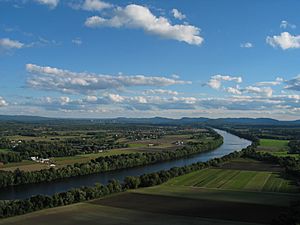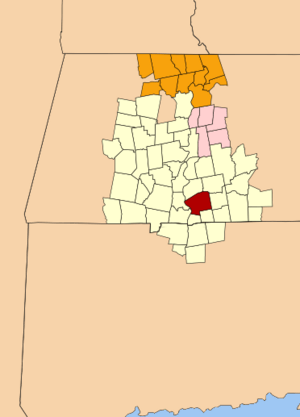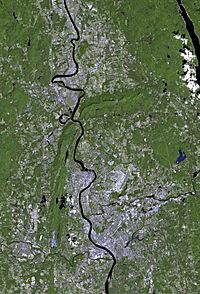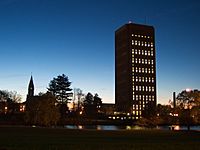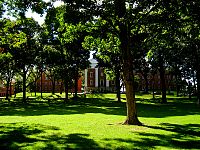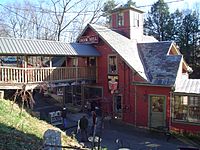Pioneer Valley facts for kids
The Pioneer Valley is a special name for the part of the Connecticut River Valley that is in Massachusetts, United States. It usually includes three counties: Hampden, Hampshire, and Franklin. The southern part of the Pioneer Valley is home to the Springfield area, which is the main city hub. Further north, you'll find smaller cities like Northampton and Greenfield.
Long ago, the northern part of the Valley was mostly farmland. Farmers grew special crops like Connecticut shade tobacco and Hadley asparagus. But since the late 1800s, the economy has changed. Now, it's more about knowledge and education, thanks to the Five Colleges in Hampshire County. Cities like Springfield, Chicopee, and Holyoke used to make things like paper and weapons. Today, they focus on special manufacturing and services for bigger cities like Boston and New York.
Many towns here have lots of forests. Springfield itself was once called "The City in a Forest" because it has so much nature and over 12% parkland. The Pioneer Valley is famous for its beautiful views and is a great place for vacations. You can see the Holyoke Range, Mount Tom Range, and many rolling hills and meadows. The Connecticut River, the longest and largest river in New England, flows through this lovely area.
Contents
- Fun Places to Visit in the Pioneer Valley
- How the Pioneer Valley Was Formed
- Exploring the Counties of the Pioneer Valley
- People and Cultures of the Pioneer Valley
- Colleges and Universities
- History of the Pioneer Valley
- Culture and Fun in the Pioneer Valley
- Economy of the Pioneer Valley
- Protecting Nature in the Pioneer Valley
- Images for kids
Fun Places to Visit in the Pioneer Valley
The Pioneer Valley is a popular spot for tourists all year round. People have been visiting for a long time! Travelers come here for many reasons:
- Lively College Towns: Places like Northampton and Amherst are busy and fun because of their colleges.
- Springfield: This city is growing and has lots to see.
- Beautiful Nature: There are many parks and places for outdoor activities.
- Six Flags New England: This is New England's biggest and most popular amusement park, located in Agawam.
- History and Culture: You can visit the Emily Dickinson House in Amherst, the Springfield Armory National Historical Site, and the Basketball Hall of Fame in Springfield.
- Winter Sports: Enjoy skiing at places like Berkshire East and Blandford Ski Resort.
- Festivals: Millions of people visit for events like The Big E, which is a huge annual fair for all six New England states in West Springfield. Another popular event is Bright Nights at Springfield's Forest Park, a fantastic light display during the holidays.
How the Pioneer Valley Was Formed
The Pioneer Valley is about half of the southern Connecticut River Valley. This valley is an ancient "rift valley." A rift valley forms when the Earth's crust pulls apart. This one was created when the huge supercontinent called Pangea broke up millions of years ago, during the Triassic and Jurassic periods.
The Connecticut River has flowed through this valley for millions of years. During the last ice age, a natural dam formed, creating a huge glacial lake called Lake Hitchcock.
The Pioneer Valley is special because it sits between two mountain ranges. To the west are the old Berkshire Mountains. To the east are other worn-down ridges. These old rocks now form many sharp hills and mountains in the Valley. Long ago, this part of the Connecticut River Valley was a shallow arm of the sea. This left behind rich deposits, making the soil in the Pioneer Valley very fertile.
You can find interesting geological features here. There are basalt rock formations and dinosaur tracks in South Hadley and Holyoke, Massachusetts. A chain of basaltic ridges called Metacomet Ridge runs along the ancient rift, including the Mount Holyoke and Mount Tom ranges. You can also see layers of rock and deltas left by Lake Hitchcock during the Ice Age.
Exploring the Counties of the Pioneer Valley
The Pioneer Valley includes the fertile Connecticut River Valley and the hill and mountain towns around it. It's made up of three counties, each with its own unique feel:
Franklin County: Outdoor Adventures
Franklin County is the most rural county in Massachusetts. It feels a lot like southern Vermont, which it borders. Greenfield is its biggest town and is often a starting point for many outdoor activities. You can go downhill skiing at places like Berkshire East, try white-water rafting, zip-lining, hiking, and kayaking.
Franklin County also has many old mill towns that are now charming and scenic, like Turners Falls. Routes 2 and 2A, which go through the county, are famous for their many antique stores.
Hampshire County: College Life and Culture
Hampshire County is home to the Five Colleges. These are UMass Amherst, Amherst, Mount Holyoke, Smith, and Hampshire. These highly respected colleges create a lively college town atmosphere, especially in Northampton and Amherst.
Most of Hampshire County's cultural events, nightlife, and music venues are in these two small but energetic cities, which are only 7 miles apart. While these college towns are known for their open-mindedness and different cultures, many of the county's other towns keep their traditional, quiet charm. Hampshire County is known for being one of the most liberal areas in the United States.
Hampden County: History and Innovation
Hampden County is the most urban county in Western Massachusetts. However, it's often described as having "cities amidst forests." Springfield, Massachusetts is the main city, located where three important rivers flow into the Connecticut River: the Westfield River, the Chicopee River, and the Mill River.
Springfield has a long and interesting history. It was once a very important center for making precision goods and weapons, especially at the Springfield Armory. This armory was chosen by General George Washington himself in 1777. After a period of decline, Springfield has been growing again since about 2006. Billions of dollars have been invested, and crime has gone down.
Springfield has many attractions for visitors:
- The Basketball Hall of Fame.
- The Springfield Armory National Historic Site.
- The Dr. Seuss Memorial garden.
- Five world-class art, science, and history museums at the Quadrangle.
- Forest Park, a large city park designed by Frederick Law Olmsted, who also designed New York City's Central Park.
Springfield's economy is diverse. It's home to MassMutual Insurance, a very wealthy company, as well as many universities and hospitals. The city also has thousands of beautiful Victorian era homes, like the "Painted Ladies" in the McKnight Historic District.
Just south of Springfield, in Agawam, is Six Flags New England amusement park. One mile west, in West Springfield, is The Big E fairgrounds. North of Springfield, in Chicopee, is the U.S. Westover Air Force Base. Chicopee is also where the fast-moving Chicopee River meets the Connecticut River. The Chicopee River has the largest water basin in Massachusetts.
Across the Connecticut River from Chicopee, in Holyoke, you'll find the Holyoke Mall at Ingleside, one of New England's largest malls. Holyoke is also home to the Mount Tom Range and the Volleyball Hall of Fame. Did you know that volleyball was invented in Holyoke in 1895?
The city of Westfield has Westfield State University. Nearby, you can find many outdoor activities like skiing at Blandford Ski Area and white-water rafting on the Westfield River.
The main airport for Hampden County and the Pioneer Valley is Bradley International Airport. It's located 12 miles south of Springfield in Windsor Locks, Connecticut.
People and Cultures of the Pioneer Valley
Different Backgrounds
The Pioneer Valley has a mix of different cultures. It was mostly British until the 1800s, then many European immigrants arrived. Now, there's a fast-growing Hispanic population, especially Puerto Ricans, in many urban areas. Among European-Americans, you'll find people with Irish, Italian, Polish, Portuguese, French Canadian, and Greek backgrounds. In 2011, Springfield also had many Vietnamese immigrants, and more Russian and Ukrainian immigrants were moving to Springfield, West Springfield, and Westfield.
LGBT Community
The Pioneer Valley has one of the highest numbers of lesbian, gay, bisexual, and transgender (LGBT) people in the United States. In 2010, Springfield was even ranked among the Top 10 gay cities in the U.S. The cities of Northampton and Springfield have very active LGBT communities. Unlike some other places, LGBT people in the Pioneer Valley often mix with straight people in bars, clubs, and cultural spots. Both cities have a lively LGBT nightlife, especially Northampton for lesbians and Springfield for gay men. College towns like Amherst and South Hadley also have many LGBT residents.
Colleges and Universities
The Pioneer Valley is a hub for higher education, with many colleges and universities.
Five College Consortium
These five colleges work together, allowing students to take classes at any of them:
- Amherst College - Amherst
- Hampshire College - Amherst
- Mount Holyoke College - South Hadley
- Smith College - Northampton
- University of Massachusetts Amherst - Amherst
Springfield Area Universities
Several other universities are located in and around Springfield:
- American International College - Springfield
- Bay Path University - Longmeadow
- Cambridge College - Springfield
- Elms College - Chicopee
- Springfield College - Springfield
- Western New England University - Springfield
- Westfield State University - Westfield
Community Colleges
- Greenfield Community College – Greenfield
- Holyoke Community College – Holyoke
- Springfield Technical Community College - Springfield
History of the Pioneer Valley
Native American history in the Pioneer Valley goes back thousands of years. The recorded history with European settlers began in 1635. That's when William Pynchon sent scouts to find the best spot in the Connecticut River Valley for trade and farming. For the first 16 years, Springfield was the only European settlement in the Pioneer Valley.
Springfield was chosen because it's a natural crossroads where four rivers meet: the Westfield River, the Connecticut River, the Chicopee River, and the Mill River.
First European Settlement
When the English explorers arrived, they found the Pocomtuc (or Nipmuck) Native American village of Agawam on the western bank of the Connecticut River. The colonists built a house in what is now Agawam, Massachusetts.
In 1636, Pynchon led a larger group of settlers. Springfield was the first settlement in Massachusetts not founded for religious reasons, though many settlers were very religious. Pynchon's group bought land on both sides of the Connecticut River from 18 tribesmen. The price was 18 hoes, 18 fathoms of wampum, 18 coats, 18 hatchets, and 18 knives. The settlement was first called Agawam Plantation. Pynchon chose this spot because it was just north of Enfield Falls, a waterfall where all river travelers had to stop and move their goods to smaller boats. This meant all trade moving north had to go through his town.
After Native Americans warned them about flooding on the west side of the river, most settlers moved to the east side. The first land grants were made in what is now Springfield's Metro Center. The main business for Springfield was trading beaver skins with the Native Americans, which were then sent all over the world.
Becoming Part of Massachusetts
In 1640 and 1641, Springfield decided to join the Massachusetts Bay Colony instead of the Connecticut Colony. This happened after a disagreement about buying corn from the Native Americans during a time of scarcity. William Pynchon, who believed in peaceful negotiation, refused to buy corn at inflated prices. The other Connecticut settlements sent Captain John Mason, who used force to get the corn. Pynchon's settlement supported him and voted to separate from Connecticut.
The Massachusetts Bay Colony then named William Pynchon the leader of Agawam. In his honor, the settlement was renamed Springfield, after the village in England where Pynchon was born. For many years, Springfield was the westernmost English settlement in Massachusetts.
Northampton: "The Midst of the River"
The area now called Northampton was originally known as Norwottuck or Nonotuck by the Pocomtuc people. This name means "the midst of the river." Northampton was likely named after John King, one of its first settlers, who came from Northampton, England.
The Pocumtuc people lived in the Connecticut River Valley. They were part of the Algonquian group and were friends with the Mahican people to the west. However, conflicts with the Iroquois and Mohawk nation weakened them. A major smallpox outbreak in the 1630s also greatly reduced their numbers.
In 1653, settlers from Springfield, Massachusetts bought the land that makes up modern Northampton. The situation worsened when the Mohawk attacked the Pocumtuc and other Algonquian tribes after 1655. This led many weakened Algonquian groups to join forces, which contributed to King Philip's War.
Northampton's Changing Borders
Northampton's territory grew, but later parts of it became separate towns. For example, Southampton was formed in 1775, and included parts of what are now Montgomery and Easthampton. Westhampton was formed in 1778, and Easthampton in 1809. A section of Northampton called Smith's Ferry was later given to Holyoke, Massachusetts in 1909.
Deerfield: Frontier Outpost
Deerfield was a very important outpost for New England settlements in the late 1600s and early 1700s. It's in a fertile part of the Connecticut River Valley but was easy to attack because it was near the Berkshire Mountains. Because of this, it saw many battles between English, French, and Native American groups.
The area was first home to the Algonquian-speaking Pocomtuc nation. English colonists settled Deerfield in 1673. The settlers forced the Pocumtuc tribe out, and they sought protection from the French in Canada.
In 1675, at the Battle of Bloody Brook, dispossessed Native Americans attacked a small colonial force. In retaliation, Captain William Turner led a surprise attack on Peskeompskut in 1676, killing 200 Native Americans.
On February 29, 1704, during Queen Anne's War, French and Native American forces attacked Deerfield. They destroyed the town and killed 56 colonists. They took 109 survivors, including women and children, on a long journey to Quebec. Many died along the way.
Deerfield and other communities raised money to rescue the captives. Many were returned, but some, like Reverend John Williams' daughter Eunice, chose to stay with the Native American tribes they had been adopted into.
As the frontier moved north, Deerfield became a quieter colonial town. In 1753, Greenfield became a separate town. In the 1800s, Deerfield's farming role declined as the Midwestern United States became the nation's main food producer.
In the late 1800s, people in Deerfield became interested in their town's past. They founded the Pocumtuck Valley Memorial Association in 1870 and put up monuments. Today, tourism is very important to the town. Historic Deerfield, a National Historic Landmark with museums, and the Yankee Candle Company are big attractions.
Later, immigrants from Eastern Europe, especially Poland, moved to Deerfield. They were mostly Catholic farmers who built their own churches.
Greenfield: A Mill Town Grows
The Pocomtuc Indians were the first people to live in the Greenfield area. Artifacts found here show that people lived here between 7,000 and 9,000 years BC. The Pocumtucks farmed and fished, but the Mohawks wiped them out as a tribe in 1664.
After that, the English colonized the area in 1686 as part of Deerfield. In 1753, Greenfield became its own town, named after the Green River.
In 1795, the South Hadley Canal opened. This allowed boats to bypass waterfalls and reach Greenfield via the Connecticut River. Greenfield is located where the Deerfield River and Green River meet, and not far from where they join the Connecticut River. This made it a good place for trade. It became the county seat when Franklin County was created in 1811. The waterfalls provided water power for factories, and Greenfield grew into a successful mill town.
Culture and Fun in the Pioneer Valley
Hampshire County: Arts and Ideas
People in Hampshire County enjoy a rich cultural scene. There are many art galleries, theaters, and performances. Famous children's authors like Dr. Seuss and Eric Carle lived here, and you can visit the Eric Carle Museum of Picture Book Art in Amherst.
Northampton is known for having a high number of lesbians in the United States. The band Pixies even sang about the "Valley full o' Pioneer" in their song "U-Mass".
Springfield: A City of Firsts
Springfield has made many important cultural contributions to the U.S. and the world.
- Basketball: In 1891, basketball, now the world's second most popular sport, was invented in Springfield.
- Automobile and Motorcycle: In 1892-93, the first working American gasoline-powered car was made in Springfield by the Duryea Brothers. It also won the world's first car race in 1895. In 1901, the first motorcycle company, "Indian," started in Springfield.
- Fire Engines and Radio: In 1905, the first modern fire engines were made in Springfield. The first commercial radio station in the U.S., WBZ, started broadcasting from Springfield in 1921.
Other important historical events in Springfield include:
- The first U.S. witch trial in 1646, decades before the Salem Witch Trials.
- The New World's first banned book, The Meritorious Price of Our Redemption, written by city founder William Pynchon in 1650.
- In 1860, Milton Bradley invented and produced his popular board games, including The Game of Life.
- Dr. Seuss grew up in Springfield and wrote some of his famous books there.
- The famous abolitionist John Brown lived in Springfield from 1846 to 1850. He met leaders like Frederick Douglass and Sojourner Truth there. He also started his first anti-slavery group, The League of Gileadites, in response to the Fugitive Slave Act.
- The 1675 Attack on Springfield during King Philip's War.
- The Springfield Armory became a very important military site after George Washington founded it.
- Shays' Rebellion, which led to the U.S. Constitution, happened at the Armory.
Springfield also has a rich literary history:
- The world's first American-English dictionary was published in Springfield in 1806 by Merriam Webster.
- The first major U.S. history book was written by Springfielder George Bancroft in 1830.
Springfield has been a very innovative city:
- In 1819, Thomas Blanchard invented the lathe in Springfield, which helped create interchangeable parts and the assembly line. He also built the first American steam-powered car in 1825.
- In 1844, Charles Goodyear perfected and patented his process for making vulcanized rubber in Springfield.
- In 1868, Margaret E. Knight invented a machine for folding and gluing flat-bottomed paper bags.
Other firsts from Springfield include:
- The first U.S. postcard in 1873.
- The first American national horse show in 1853.
- The first American dog show.
- The first American friction match in 1834.
Art and Museums
People in the Valley love art and performances. There are many art galleries and theaters. Springfield's Quadrangle has five museums: two art museums, two history museums, and one science museum. The Science Museum has the first planetarium in the United States. The Dr. Seuss Memorial garden, with bronze sculptures of his characters, is also there.
Springfield Symphony Hall is the main place for classical music, Broadway shows, and concerts in the Valley. It was built in 1911-13 and is beautiful inside. CityStage is another major playhouse in Springfield.
Local Media
You can find out what's happening in the Pioneer Valley through various local media:
- The Valley Post
- The Republican (Springfield's main newspaper)
- The Valley Advocate, an arts and entertainment newspaper
- The Rainbow Times, an LGBT magazine for the Pioneer Valley
- The Valley Art Newsletter
Independent Bookstores
The Pioneer Valley is a paradise for readers, with independent bookstores in almost every town. There are also several small publishers and many local authors.
- Amherst has at least four bookstores.
- South Hadley has The Odyssey Bookshop.
- Montague has The Bookmill.
- Greenfield has World Eye Bookshop and John Doe, Jr. used books.
- Northampton has at least four independent bookstores, including Broadside Bookshop and Raven Used Books.
- South Deerfield has New England Auctions, which specializes in rare books.
Sports in the Valley
The Pioneer Valley has a rich sports history and many teams.
The Springfield Thunderbirds are the region's only professional sports team, playing in the American Hockey League. Springfield has had professional hockey since the 1930s with the successful Springfield Indians. The area has also had minor-league baseball teams.
At the college level, the University of Massachusetts is a top-tier NCAA Division I school. The ice hockey team at American International College also competes at the Division I level. There are many well-known NCAA Division III schools, like Amherst College.
The Holyoke Blue Sox are a notable amateur baseball team.
Many famous athletes have played or lived in the region:
- Eddie Shore played for and owned the Springfield Indians.
- Julius Erving, one of the best basketball players ever, played at UMass Amherst.
- Wrestler John Cena went to Springfield College.
- Hockey player Bill Guerin, a Stanley Cup champion, is from Wilbraham.
The region also hosts independent professional wrestling shows.
The Pioneer Valley is famous for being the birthplace of two major sports: basketball (invented at Springfield College) and volleyball (invented in Holyoke). The Naismith Memorial Basketball Hall of Fame and the Volleyball Hall of Fame are located in these cities.
Economy of the Pioneer Valley
The Pioneer Valley used to be known for growing Connecticut shade tobacco. Today, it has a diverse economy. It's home to over 16 universities and colleges, many of which are considered among the best in the U.S. There are also many hospitals and healthcare organizations, like Baystate Health, which is Massachusetts' third-largest employer. Financial service organizations, like the Fortune 100 company MassMutual, are also here.
Manufacturing is still part of the economy, with companies like Smith & Wesson. However, manufacturing has decreased since the Springfield Armory closed in 1968. The Pioneer Valley has a "mature economy," meaning it's diverse enough not to depend on just one industry. This helped it do well during the Great Recession.
Franklin County: Farming and Small Businesses
Franklin County in the north is an important farming area because of its rich topsoil. Sweet corn and asparagus are major crops. You'll see many fields of corn and tobacco, as well as farmhouses and tobacco barns. Light industry is in South Deerfield and Greenfield, and service industries are throughout the county.
Franklin County is also becoming a place where people live but work elsewhere. Major roads like Interstate 91 and Route 2 make it easy to commute.
Two big companies, Channing Bete and Yankee Candle, have their main offices in South Deerfield and Greenfield. Greenfield even gained national attention for preventing a Wal-Mart store from being built there.
Tourism is also important. Attractions include Historic Deerfield and a Butterfly Garden in South Deerfield. Many tourists visit in the autumn to see the beautiful fall foliage.
Hampshire County: Education and Liberal Values
With the Five Colleges, a big part of Hampshire County's economy is serving university students. This includes many independent bookstores and shops. Hampshire County is also one of the most politically liberal counties in the U.S., largely due to Northampton, Amherst, and the large LGBT community around the colleges.
The area has many restaurants, from sports bars to steakhouses. Northampton is a culinary center for Western Massachusetts and a hub for the lesbian community.
Hampden County: Major Economic Hub
Hampden County's economy is centered on Springfield, Massachusetts. Springfield is a major transportation hub, located between Boston and Albany, New York, and close to New York City. Many recent economic projects in Springfield are related to transportation, like the Knowledge Corridor intercity rail line. Springfield is also a center for medicine, government, and higher education.
Manufacturing still exists in Springfield, even after a big decline in the late 1900s. For example, Smith & Wesson added 225 new jobs to its Springfield headquarters in 2011.
Chicopee continues to grow, especially around Westover Air Force Base.
Most other towns in Hampden County are either wealthy suburbs (like Longmeadow, Massachusetts and Wilbraham, Massachusetts) or rural areas (like Palmer, Massachusetts and Brimfield, Massachusetts). Hampden County also has many natural areas like the Mount Tom and Mount Holyoke Ranges.
Tourism is very popular in Hampden County:
- Six Flags New England has a top-ranked roller coaster and draws tourists from everywhere.
- The Basketball Hall of Fame attracts hundreds of thousands of visitors each year.
- The Springfield Armory National Historic Site is Western Massachusetts' only national park.
- The Quadrangle in Springfield has five museums and the Dr. Seuss National Memorial Sculpture Garden.
- Forest Park (Springfield), designed by Frederick Law Olmsted, is one of the largest urban parks in the U.S. During the holidays, it has a famous light display called "Bright Nights."
- The Big E, the fair for all New England states, draws millions of visitors every September-October.
- Springfield's "Parade of Big Balloons" happens on November 1st, using many balloons from Macy's Thanksgiving Day Parade.
- The Hoops City Jazz Festival in July brings many people to Metro Center.
- The Springfield Grand Prix, a vintage sports car race, started in 2012.
- Rural towns like Tolland offer outdoor activities like camping.
Politically, Hampden County tends to be liberal, but it also has some conservative towns like Holyoke, Westfield, and Agawam. Springfield, while historically moderate, has become more liberal in recent years.
Protecting Nature in the Pioneer Valley
People in the Pioneer Valley have always valued nature. There are many non-profit nature sanctuaries, like Friends of Wissatinnewag, Inc., a sacred Native American burial ground. There are also historic parks like King Phillip's Stockade in Springfield, the large Forest Park, and Western Massachusetts' only national park, the Springfield Armory National Historic Site.
The Great Falls Discovery Center, a visitor center for the Silvio O. Conte National Fish and Wildlife Refuge, is in Turners Falls. There are also hundreds of state and local parks and forests.
Because of its natural beauty, environmental groups have worked hard to protect unspoiled nature, especially along the Connecticut River and in the rural "hilltowns." They focus on wildlife habitats, rare plants, and recreational areas like the Metacomet-Monadnock Trail. They also protect the rich farming soils in towns like Hadley, Massachusetts. Local and national conservation groups help by owning conservation areas and land under conservation easement. Many towns also have their own conservation areas.
One important area includes Mount Tom State Reservation, Mount Holyoke Range State Park, and Skinner State Park. These, along with the Arcadia Wildlife Sanctuary, form a long wildlife corridor across the Connecticut River.
Recently, there's been an effort to make Springfield's waterfront more accessible. It's currently separated from the city by the eight-lane Interstate 91 highway. In 2010, the Urban Land Institute suggested ways Springfield could reconnect with the Connecticut River.
Images for kids
-
The Connecticut River, looking southward over Sunderland from Deerfield.


